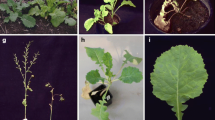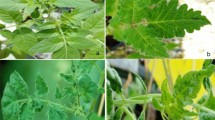Abstract
A damaging virus isolated in the Netherlands from lettuce was studied and compared with a virus isolated from dandelion orginating from Czechoslovakia. It was found to biologically resemble dandelion yellow mosaic virus incompletely described from dandelion and lettuce in Great Britain (Kassanis, 1944, 1947) and from dandelion in Germany (Hein, 1963).
Mechanical transmission was greatly improved by buffer solution and transmission byMyzus persicae seemed to be in the non-persistent manner. Longevity in vitro of the virus hardly exceeded one day. Thermal inactivation was between 60 and 65 °C and the dilution end-point was between 10 000 and 100 000. It was still infectious in leaf material dried and stored over CaCl2 at 4 °C for 6 1/2 years.
The virus was isolated and purified with difficulty and was found to consist of one type of spherical particle of ca 30 nm diameter, with a sedimentation coefficient of 159 S, a buoyant density of 1.42 g.cm−3 and an A260/A280 ratio of 1.67. An antiserum was prepared with a titre of 256 in the agar double-diffusion test. The virus could be identified in crude extracts from lettuce andChenopodium amaranticolor by enzyme-linked immunosorbent assay (ELISA), but not by agar double diffusion. It could only be visualized in crude sap in the electron microscope after trapping of virus particles on antiserum-coated grids. The virus cannot yet be assigned to any known virus group.
It is of potential economic importance to lettuce because of its occurrence in widely differing regions in Europe, its aggressiveness and virulence on 22 out of 23 lettuce cultivars tested (and on endive) and its pathogenicity toLactuca genotypes which are resistant to lettuce mosaic virus and other important pathogens of lettuce. ‘Laibacher Eis’ was the only cultivar showing some tolerance.
Similar content being viewed by others
References
Bos, L., Huttinga, H. & Maat, D.Z., 1980. Spinach latent virus, a new ilarvirus seed-borne inSpinacia oleracea. Neth. J. Pl. Path. 86: 79–98.
Brčák, J., 1979. Czech and Scandinavian isolates resembling dandelion yellow mosaic virus. Biologia Pl. 21: 298–301.
Brčák, J. & Polák, Z., 1966. Importance of wild hosts of plant viruses. Meded. Fac. Landb.wet. Rijksuniv. Gent. 31: 967–973.
Čech, M. & Branišová, H., 1973. Some problems with the isolation of theTaraxacum mosaic virus. Plant Virology, Proc. 7th. Conf. Czechosl. Pl. Virol., High Tatras 1971: 263–266.
Clark, M.F. & Adams, A.N., 1977. Characteristics of the microplate method of enzyme-linked immunosorbent assay for the detection of plant viruses. J. gen. Virol. 34: 475–483.
Flegg, C.L. & Clark, M.F., 1979. The detection of apple chlorotic leafspot virus by a modified procedure of enzyme-linked immunosorbent assay (ELISA). Ann. appl. Biol. 91: 61–65.
Gérola, F.M., Lombardo, G. & Catara, A., 1969. Histological localization of citrus infectious variegation virus (CVV) inPhaseolus vulgaris. Protoplasma 67: 319–326.
Hein, A., 1963. Über ein Vorkommen des Salatnekrosevirus in West Deutschland. NachrBl. dt. PflSchutzdienst, Braunschweig 51: 17–20.
Kassanis, B., 1944. A virus attacking lettuce and dandelion. Nature 154: 6.
Kassanis, B., 1947. Studies on dandelion yellow mosaic and other virus diseases of lettuce. Ann. appl. Biol. 34: 412–421.
Kim, K.S. & Fulton, J.P., 1971. Tubules with viruslike particles in leaf cells infected with bean pod mottle virus. Virology 43: 329–337.
Markham, R., 1960. A graphical method for the rapid determination of sedimentation coefficients. Biochem. J. 77: 516–519.
Moore, W.C., 1946. A virus disease of Cos-lettuce (dandelion yellow mosaic virus). Trans. Br. mycol. Soc. 29: 252–253.
Murant, A.F., 1981. Neproviruses. In: E. Kurstak (ed).) Handbook of plant virus infections; comparative diagnosis. Elsevier/North Holland, Amsterdam p. 197–256.
Roberts, I.M. & Harrison, B.D., 1970. Inclusion bodies and tubular structures inChenopodium amaranticolor plants infected with strawberry latent ringspot virus. J. gen. Virol. 7: 47–54.
Rønde Kristensen, H., 1966. Plant virus diseases in the Scandinavian countries. Rev. Roum. Biol. Ser. Bot. 11: 115–119.
Rønde Kristensen, H., Tapio, E. & Lihnell, D., 1965. List of plant viroses occurring in the Nordic countries: 25 pp.
Scheer, C. van der & Groenewegen, J., 1971. Structure in cells ofVigna unguiculata infectd with cowpea mosaic virus. Virology 46: 493–497.
Serjeant, E.P., 1967. Some properties of cocksfoot mottle virus. Ann. appl. Biol. 59: 31–38.
Shikata, E. 1981. Reoviruses. In: E. Kurstak (Ed.), Handbook of plant virus infections; comparative diagnosis. Elsevier/North Holland, Amsterdam, p. 423–451.
Tóbiás, I., Maat, D.Z. & Huttinga, H. 1982. Two Hungarian isolates of cucumber mosaic virus from sweet pepper (Capsicum annuum) and melon (Cucumis melo): identification and antiserum preparation. Neth. J. Pl. Path. 88: 171–183.
Author information
Authors and Affiliations
Rights and permissions
About this article
Cite this article
Bos, L., Huijberts, N., Huttinga, H. et al. Further characterization of dandelion yellow mosaic virus from lettuce and dandelion. Netherlands Journal of Plant Pathology 89, 207–222 (1983). https://doi.org/10.1007/BF01976787
Accepted:
Issue Date:
DOI: https://doi.org/10.1007/BF01976787




